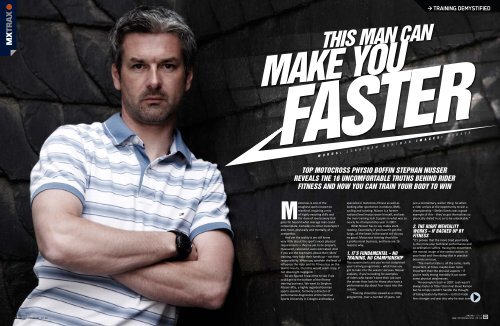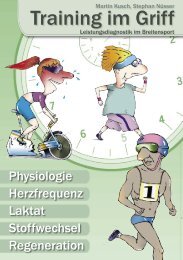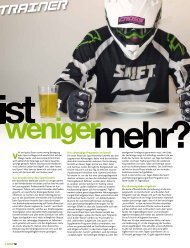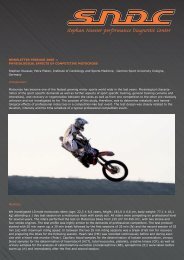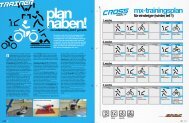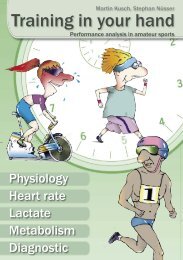Create successful ePaper yourself
Turn your PDF publications into a flip-book with our unique Google optimized e-Paper software.
TRAINING DEMYSTIFIED<br />
THIS MAN CAN<br />
MAKE YOU<br />
FASTER<br />
W O R D S : J O N A T H A N B E N T M A N I M A G E S : R E D E Y E<br />
TOP MOTOCROSS PHYSIO BOFFIN STEPHAN NUSSER<br />
REVEALS THE 16 UNCOMFORTABLE TRUTHS BEHIND RIDER<br />
FITNESS AND HOW YOU CAN TRAIN YOUR BODY TO WIN<br />
Motocross is one of the<br />
toughest sports known to<br />
mankind, requiring a mix<br />
of highly exacting skills and<br />
fair dose of raw bravery that<br />
goes far beyond what average man could<br />
contemplate. Certainly no other motorsport<br />
asks <strong>more</strong>, physically and mentally, of a<br />
competitor.<br />
And yet the reality is we still know<br />
very little about the sport’s exact physical<br />
requirements – they’ve yet to be properly<br />
measured, calculated, even estimated. And<br />
if you ask the top teams about their ri<strong>de</strong>rs’<br />
training, they hold their hands up – not their<br />
responsibility. When you consi<strong>de</strong>r the level of<br />
influence the ri<strong>de</strong>r and his fitness has on the<br />
team’s results, then this would seem crazy, if<br />
not downright negligent.<br />
So we figured it was time to see if we<br />
could get to the bottom of the fitnesstraining<br />
business. We went to Stephan<br />
Nüsser MSc, a highly regar<strong>de</strong>d German<br />
sports scientist, formerly a director of<br />
performance diagnostics at the German<br />
Sports University in Cologne and today a<br />
specialist in motocross fitness as well as<br />
looking after sportsmen in enduro, BMX,<br />
cycling and running. Nüsser is a former<br />
national level motocrosser himself, and was<br />
the man training Josh Coppins in what was so<br />
nearly his championship year in 2007.<br />
What Nüsser has to say makes stark<br />
<strong>read</strong>ing. Essentially, if you haven’t got the<br />
lungs, all the heart in the world will do you<br />
no good. Motocross training should be<br />
a professional business, and here are 16<br />
reasons why.<br />
1. IT’S FUNDAMENTAL – NO<br />
TRAINING, NO CHAMPIONSHIP<br />
The season starts and you’ve not completed<br />
your training programme – what have you<br />
got to take into the season: excuses. Nüsser<br />
explains, if you’re looking for examples<br />
of ri<strong>de</strong>rs who haven’t done their job over<br />
the winter then look for those who have a<br />
performance dip about four races into the<br />
season.<br />
“Training should be viewed as a rolling<br />
programme, over a number of years, not<br />
just a momentary, winter thing. So when<br />
a ri<strong>de</strong>r arrives at the opportunity to win a<br />
championship – Stefan Everts was a good<br />
example of this – they’ve got themselves so<br />
physically dialed in so as to be unbeatable.”<br />
2. THE RIGHT MENTALITY<br />
WORKS – IF BACKED UP BY<br />
FITNESS<br />
“It’s proven that the <strong>more</strong> tired your body<br />
is, the <strong>more</strong> your technical performance and<br />
co-ordination suffers. Having the movement,<br />
the mental image of the control action, in<br />
your head and then doing that in practice<br />
becomes an issue.<br />
“The mental state is, all the same, really<br />
important, at times maybe even <strong>more</strong><br />
important than the physical aspects – if<br />
you’re really strong mentally it can cover<br />
some physical weaknesses.<br />
“An example is Josh in 2007. Josh wasn’t<br />
always faster or fitter than rival Steve Ramon<br />
but he simply couldn’t handle the thought<br />
of being beaten by Ramon – so that ma<strong>de</strong><br />
him stronger and was also why he won some<br />
104<br />
JANUARY 2010<br />
WWW.MOTOMAGAZINE.CO.UK<br />
JANUARY 2010<br />
WWW.MOTOMAGAZINE.CO.UK<br />
105
TRAINING DEMYSTIFIED<br />
asons ago we felt we had the world<br />
on the ropes, with Tommy Searle<br />
regularly kicking around the M<br />
asons ago we felt we had the world on the ropes, with Tommy Searle regularly kicking around the M asons ago we felt we had the world on the ropes, with Tommy Searle<br />
regularly kicking around the M asons ago we felt we had the world on the ropes, with Tommy Searle regularly kicking around the M asons ago we felt we had the world on t<br />
TOP MOTOCROSS PHYSIO BOFFIN STEPHAN NUSSER REVEALS THE 16<br />
UNCOMFORTABLE TRUTHS BEHIND RIDER FIT<br />
it is to improve your performance in just those<br />
four months. Motocross training is tough because<br />
you are constantly running out of time. Once the<br />
season has started you can’t do lots of endurance<br />
training as you are riding, travelling, or at the<br />
races. Whereas a cyclist, typically with less races,<br />
with <strong>more</strong> sport-specific training available year<br />
round, can continue to lift his fitness throughout<br />
the year.”<br />
6. THE BASE FITNESS COMES<br />
FROM LOW INTENSITY TRAINING –<br />
WITHOUT IT YOU’RE SCREWED<br />
Base training is generally done at lower<br />
intensities over a long term. Short term fix-its<br />
usually result in short term results.<br />
“Training wise, in a short period of time<br />
with just short high-intensity training you really<br />
can lift your performance. But the peak of that<br />
performance will only stay for a very short time<br />
and you can’t maintain that high peak for months<br />
or 10 weeks even, it’s just for two to three weeks<br />
and then the performance goes down. To have<br />
a <strong>more</strong> or less constant performance over the<br />
whole season you need a good base and that you<br />
get through a lot of volume. And to get a lot of<br />
volume you have to be careful with the intensity.<br />
“And this is not just over one year, your<br />
performance increases over many years. It’s a<br />
long path to peak physical fitness.<br />
“My experience with Josh was that he came to<br />
me al<strong>read</strong>y at a good level and we were able to<br />
build on that for the next five years. If you have<br />
someone at an average level you can still keep<br />
improving their fitness for six to eight years. Take<br />
someone who starts with you at 16, like say Ken<br />
Roczen, then you can improve their fitness for 10<br />
years, until they are 26 - the physical peak for all<br />
men.”<br />
7. OLD SCHOOL METHODS ARE<br />
OUTDATED<br />
That old beast-yourself-flat-out and then honk<br />
style of training is no use to a professional racer.<br />
“Yes, it will <strong>de</strong>velop your fitness a little bit, but<br />
only to a certain stage. You have to see where<br />
you’ve come from. If you’re an absolute beginner<br />
you can do anything and you will improve, you<br />
can train clever, you can train stupid – you will see<br />
improvement simply because you are doing some<br />
training rather than no training. But the fitter<br />
and the higher the level you are at, the <strong>more</strong> and<br />
<strong>more</strong> difficult it becomes to make improvements.”<br />
races ahead of Ramon, because he had so much<br />
<strong>de</strong>sire to beat him.<br />
“But iron will can’t overcome serious<br />
shortcomings. If someone always crashes in<br />
the last 10 minutes of a moto then, whatever<br />
his excuses, I would say that the crash was a<br />
symptom of a physical or concentration problem,<br />
which is for sure connected.”<br />
3. VO2 MAX DOESN’T LIE, BUT IT<br />
DOESN’T GIVE THE WHOLE PICTURE<br />
EITHER<br />
The VO2 max test – where a ri<strong>de</strong>r runs on a<br />
t<strong>read</strong>mill and his oxygen consumption measured –<br />
is used to benchmark fitness. The average person<br />
processes 40 millilitres of oxygen per minute per<br />
kilogramme body weight. The higher the value<br />
the greater the overall endurance capacity of the<br />
person. Top cyclists can register a score as high as<br />
80-90. Top motocrossers typically score 60-65.<br />
“You can’t say cyclists are fitter, though. It’s<br />
important to ask what’s required from the sport in<br />
question and not always look at other sports as a<br />
measure. But you do need a good level of overall<br />
endurance to build on to achieve the bike fitness<br />
that’s required.<br />
“So the VO2 max is not a true indicator as it<br />
measures only endurance, we need to also look at<br />
strength and flexibility.”<br />
4. RIDING ON ITS OWN WILL NOT<br />
GET YOU FIT ENOUGH<br />
Nüsser explains that he sees a ri<strong>de</strong>r’s fitness<br />
comprising two parts: general fitness<br />
and sport-specific fitness.<br />
“To be awesome on a run or cycling is<br />
not enough, you need to be bike fit too – a<br />
combination of the two.<br />
“But the general fitness is the base on which<br />
the bike fitness stands – you need the overall<br />
fitness to then <strong>de</strong>velop riding fitness, without that<br />
base you won’t <strong>de</strong>velop your riding fitness.<br />
“Riding alone will not achieve the fitness<br />
level required to be able to race motos every<br />
weekend for a whole season. Even if you trained<br />
by riding five days a week, say two hours each<br />
day – of which maybe 90 minutes (max) will<br />
be at a suitable level – that only makes at most<br />
nine hours training a week and that’s simply not<br />
enough.”<br />
5. WINTER IS WHEN ALL THE HARD<br />
WORK HAS TO BE DONE<br />
“Winter training has to be intense to get to<br />
the required fitness level to start the season.<br />
As much as possible needs to be done then as<br />
come the season a lot of time is lost to recovery<br />
time outsi<strong>de</strong> of the races. A fit ri<strong>de</strong>r, after racing<br />
the weekend may need to rest until Wednesday<br />
before he can start training again. Later in the<br />
season he may even need the whole week to<br />
allow his body to recover.”<br />
How intense is the training Nüsser runs a<br />
winter camp for ri<strong>de</strong>rs and the programme breaks<br />
down to something like: two weeks, 25 hours of<br />
training each week, three training sessions a day,<br />
typically something like swim/cycle/soccer. The<br />
ri<strong>de</strong>rs are then encouraged to continue training<br />
on the basis of 20-25 hours per week for the<br />
rest of the winter. This compares to triathletes<br />
who train as much as 30 hours per week. Nüsser<br />
stresses the importance of sports-specific focus<br />
on training – majoring on leg strength, lumber<br />
strength and endurance.<br />
“You have maybe four months for preparing<br />
your endurance fitness, from November to the<br />
end of February. But the fitter you are the har<strong>de</strong>r<br />
asons ago we felt we had the world<br />
on the ropes, with Tommy Searle<br />
regularly kicking around the M<br />
106<br />
JANUARY 2010<br />
WWW.MOTOMAGAZINE.CO.UK<br />
DECEMBER 2009<br />
WWW.MOTOMAGAZINE.CO.UK<br />
107
TRAINING DEMYSTIFIED<br />
TOP MOTOCROSS<br />
PHYSIO BOFFIN STEPHAN<br />
NUSSER REVEALS THE 16<br />
UNCOMFORTABLE TRUTHS<br />
BEHIND RIDER FIT<br />
asons ago we felt we had<br />
the world on the ropes,<br />
with Tommy Searle regularly<br />
kicking around the M<br />
8. RECOVERY TIME IS<br />
UNDERVALUED<br />
“It’s a fact that a GP ri<strong>de</strong>r cannot recover<br />
overnight. You do need to take the Monday off<br />
and literally do nothing to let your body recover.<br />
And Tuesday sometimes, too. If you speak to<br />
the ri<strong>de</strong>rs they always say Tuesday is the worst<br />
because on Monday you are still fired up after<br />
the race – it really kicks in on Tuesday.<br />
“And here’s a very common mistake – many<br />
ri<strong>de</strong>rs will walk around doing shopping on their<br />
rest days. But then that’s not a recovery day. Not<br />
everyone can cope with the discipline. One of<br />
my ri<strong>de</strong>rs, Marcus Schiffer, he can’t do it. If I tell<br />
him to stay home all day, he goes nuts - he needs<br />
to be doing something. It’s easier for the ol<strong>de</strong>r<br />
ri<strong>de</strong>rs because when you are ol<strong>de</strong>r you recover<br />
slower and so you became <strong>more</strong> aware of getting<br />
in your recovery times.”<br />
9. REGULAR TISSUE DAMAGE<br />
TO MOTOCROSSERS SHOCKS<br />
DOCTORS<br />
You need those two days to let your body<br />
repair its tissue damage. Blood tests taken in<br />
this time have revealed the huge amount of<br />
tissue damage simply riding brings on. Regular<br />
doctors are shocked by the <strong>read</strong>ings, all created<br />
by the pounding from the jumps and bumps and<br />
vibration from the bike.<br />
“Basically a lot of tissue is damaged and<br />
<strong>de</strong>stroyed. We’re not talking ripped muscles but<br />
microscopically there’s really a lot of damage.<br />
With blood tests I can measure the extent<br />
of muscle damage. And after a race you get<br />
really high values, if normal doctors see these<br />
results they get scared, they don’t know what’s<br />
happening. But for me, I have seen so many high<br />
asons ago we felt<br />
we had the world<br />
on the ropes, with<br />
Tommy Searle<br />
regularly kicking<br />
around the M<br />
values for motocross ri<strong>de</strong>rs, it’s normal.<br />
“The dimension of damage or strain to the<br />
body is un<strong>de</strong>restimated. I think it’s very sports<br />
specific, although not proven or tested, but<br />
what’s important is the load after the jumps, and<br />
the vibration coming from the bike. If you jump<br />
off a chair 50 times a day that’ll come close to a<br />
simulation of what goes on for the body.”<br />
10. MID-SEASON TRAINING BURSTS<br />
CAN DO MORE HARM THAN GOOD<br />
“When you really fa<strong>de</strong> in the races it means<br />
you are going really <strong>de</strong>ep and so you’ll need a<br />
lot of recovery. But if your results are not where<br />
they should be you’d be thinking you’ll have to<br />
compensate for that with <strong>more</strong> training. But do<br />
<strong>more</strong> training and you mess up your recovery and<br />
get even <strong>more</strong> tired and fa<strong>de</strong> even quicker.<br />
“In situations like this you just have to be<br />
clever, don’t train too much and make sure you<br />
recover enough. The only reliable plan is to cruise<br />
the season and try and change the preparation<br />
for the next year. In the meantime try to make<br />
recovery as good as possible and watch the<br />
training intensities, the nutrition, the fuel intake,<br />
but <strong>more</strong> than anything make sure you have rest<br />
days.”<br />
11. FEW RIDERS REALLY<br />
UNDERSTAND FITNESS<br />
Many pound out the miles, running here and<br />
there. They diligently go to the gym and push<br />
a few weights. But how much do they really<br />
un<strong>de</strong>rstand what they should be doing, when,<br />
and how often<br />
“At GP levels the ri<strong>de</strong>rs need to have<br />
everything right. But few do. The ri<strong>de</strong>rs need a<br />
<strong>more</strong> scientific way of controlling their training,<br />
monitoring heart rate, taking performance tests,<br />
having regular blood tests to see if everything is<br />
physically all right.<br />
“With the blood tests you can also see if they<br />
are doing too much training. So you have an<br />
overtraining control unit. And you must have an<br />
experienced trainer to get the right information.<br />
“There is so much to balance – what time they<br />
should do their base training, the low intensity,<br />
what time the greater intensity. What mix of<br />
fitness training and riding training they should<br />
have How to structure their riding training –<br />
longer motos, shorter motos That’s all quite<br />
complex and the ri<strong>de</strong>rs should be sitting down<br />
in October and making a plan for the whole year<br />
and not just starting some exercise not knowing<br />
what to do next month. It really helps to have an<br />
overview of 12 months. For example: this is the prep<br />
period, the preseason period, the race period. They<br />
must have an i<strong>de</strong>a of what they must do in each<br />
period.”<br />
12. NUTRITION IS ABOUT MORE THAN<br />
JUST PASTA<br />
Nutrition is a hugely important subject but one<br />
that’s again severely neglected. Nüsser says in his<br />
experience it’s an unholy struggle to change a ri<strong>de</strong>r’s<br />
nutrition routine. Why Because it’s very difficult to<br />
take control of it, to have someone monitor what<br />
the ri<strong>de</strong>r eats during each day.<br />
“It’s about eating a good combination of<br />
everything and not touching fast food. But that’s<br />
a problem because the ri<strong>de</strong>rs are so much on the<br />
road, eating in hotels, eating at airports, so it’s not<br />
so easy for them to have the proper food all the<br />
time.<br />
“At the races it’s just as problematic. The ri<strong>de</strong>r<br />
is working at a really high intensity. The first race,<br />
<strong>de</strong>pending on the course, they’ll use up a lot of<br />
carbohydrates. But when it comes to recharging<br />
there’s a problem. From the stomach and the<br />
intestines you have a limitation on the absorption<br />
of carbs. It’s between 60 and 80 grammes per<br />
hour you can pick up. Given that rate of absorption<br />
there’s little point in eating a kilo of pasta when<br />
you can only absorb 60-80 grammes in the time<br />
between the first and second moto.”<br />
13. THE BANANA IS RUBBISH, TOO<br />
“I see many ri<strong>de</strong>rs eating bananas as an energy<br />
fix. It offers the right kind of energy but not<br />
enough. Today it’s been superse<strong>de</strong>d by the likes of<br />
the PowerBar. I still see ri<strong>de</strong>rs eating a sandwich,<br />
too, between races and that’s not an appropriate<br />
<strong>de</strong>livery of energy either in such a short time.<br />
Products like the PowerBar are specifically <strong>de</strong>signed<br />
to have a quick absorption in the body and this is<br />
the reason you see so much of them in sports such<br />
as cycling and triathlons.”<br />
14. QUALIFYING RACES IMPACT<br />
RIDER ENERGY FOR THE GP MOTOS<br />
PROPER<br />
The introduction of the 20-minute qualifying<br />
race on Saturday has had an unquantifiable impact<br />
of the ri<strong>de</strong>rs’ energies come the Sunday motos.<br />
Nüsser thinks the impact is quite significant.<br />
“The whole programme that the ri<strong>de</strong>rs do on<br />
Saturday costs a lot of energy, no question. They<br />
have to make sure that they have the proper food<br />
on Saturday night to recover, but even then I’m not<br />
sure they can refuel on everything they used on<br />
Saturday, maybe al<strong>read</strong>y they go in a little minus on<br />
Sunday morning and then they’re still not able to<br />
pick it up again.<br />
“Ri<strong>de</strong>rs and teams need to look into this<br />
refueling, to get the right mixture of carbs and<br />
proteins. Because the ri<strong>de</strong>rs will have a lot of cells<br />
<strong>de</strong>stroyed from the riding so they’ll have a lot of<br />
rebuilding processes going on in their bodies after<br />
the ri<strong>de</strong>. So therefore they need <strong>more</strong> proteins and<br />
it’s quite likely proteins are <strong>more</strong> important than the<br />
carbs in this situation.”<br />
Which could mean it’s back to steak over pasta<br />
for Saturday night!<br />
15. WATER IS RUBBISH FOR<br />
REHYDRATION<br />
A common big mistake is to just drink plain water<br />
after a race. You can in fact come to a stage where<br />
you instead <strong>de</strong>hydrate by just drinking plain water.<br />
“The fluid in the body has a certain <strong>de</strong>nsity. Plain<br />
water has less <strong>de</strong>nsity. So the body always tries to<br />
have the <strong>de</strong>nsities balanced, so if you just drink<br />
water which is low <strong>de</strong>nsity and you have body fluid<br />
that is high <strong>de</strong>nsity the body takes <strong>de</strong>nsity from the<br />
body fluid to get the water that you just drank up to<br />
the same level. So you can lose body water trying to<br />
get the water you just drank up to the same <strong>de</strong>nsity.<br />
“You can drink water, but together with sports<br />
drink, or juice, mix it up a bit.”<br />
asons ago we felt we had the world on the ropes, with<br />
asons ago we felt we had the world on the ropes, with<br />
asons ago we felt we had the world on the ropes, with<br />
16. WE KNOW SO LITTLE<br />
Nüsser is dismayed that so little research has<br />
been done on ri<strong>de</strong>r fitness and training. Compared<br />
to the approaches taken in athletics, in cycling and<br />
many other sports, so much of what’s taken as<br />
<strong>read</strong> in motocross is based on nothing <strong>more</strong> than<br />
hand-me-down examples of previous generations<br />
of ri<strong>de</strong>rs. Given the R&D that goes into the bikes,<br />
that no similar research is conducted on the<br />
ri<strong>de</strong>rs’ performance does seem a bit out of kilter –<br />
wouldn’t you say<br />
“We really need to do <strong>more</strong> research to<br />
un<strong>de</strong>rstand the sports-specific <strong>de</strong>mands and then<br />
with the conclusions we can optimise training,<br />
optimise nutrition and optimise recovery. If you look<br />
at running or cycling there is so much research done<br />
in these sports, there’s nothing in motocross yet<br />
we’re still comparing our ri<strong>de</strong>rs’ fitness to cyclists<br />
or runners. If we’re to market motocross wi<strong>de</strong>ly<br />
as a professional mo<strong>de</strong>rn sport, to call our ri<strong>de</strong>rs<br />
‘athletes’ isn’t it time we addressed this imbalance<br />
of knowledge”<br />
BILLY MACKENZIE<br />
asons ago we felt<br />
we had the world<br />
on the ropes,<br />
with Tommy<br />
Searle regularly<br />
kicking around<br />
the M asons ago<br />
BILLY MACKENZIE<br />
asons ago we felt<br />
we had the world<br />
on the ropes,<br />
with Tommy<br />
Searle regularly<br />
kicking around<br />
the M asons ago<br />
BILLY MACKENZIE<br />
asons ago we felt<br />
we had the world<br />
on the ropes,<br />
with Tommy<br />
Searle regularly<br />
kicking around<br />
the M asons ago<br />
BILLY MACKENZIE<br />
asons ago we felt<br />
we had the world<br />
on the ropes,<br />
with Tommy<br />
Searle regularly<br />
kicking around<br />
the M asons ago<br />
BILLY MACKENZIE<br />
asons ago we felt<br />
we had the world<br />
on the ropes,<br />
with Tommy<br />
Searle regularly<br />
kicking around<br />
the M asons ago<br />
BILLY MACKENZIE<br />
asons ago we felt<br />
we had the world<br />
on the ropes,<br />
with Tommy<br />
Searle regularly<br />
kicking around<br />
the M asons ago<br />
SUPERFIT<br />
SLACKER<br />
108<br />
JANUARY 2010<br />
WWW.MOTOMAGAZINE.CO.UK<br />
JANUARY 2010<br />
WWW.MOTOMAGAZINE.CO.UK<br />
109


